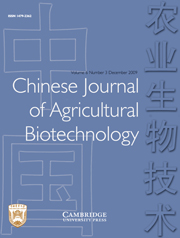No CrossRef data available.
Article contents
Isolation, mapping and application of a repetitive DNA sequence in wheat (Triticum aestivum) A and B genomes
Published online by Cambridge University Press: 29 January 2010
Abstract
Simple sequence repeat (SSR) analysis was performed on five Secale species, four Triticum species and a Triticale line Fenzhi-1 using 102 pairs of microsatellite primers. A 387-bp specific DNA fragment FZ387 (GenBank accession no. EF179137) was obtained from the Triticale Fenzhi-1 with primer Xgwm614, without amplification in Secale. NCBI BLAST revealed that this FZ387 sequence had 94% and 95% similarity to part of the Gypsy Ty3-LTR retrotransposon Fatima in Triticum monoccocum (AY485644) and Triticum turgidum (AY494981), respectively. A pair of specific polymerase chain reaction (PCR) primers, FaF and FaR, was designed based on the conserved region of this FZ387 sequence. The amplification of primer pair Xgwm614F and FaR revealed that a specific 350-bp band (designation as A350) was obtained from the species containing A chromosomes. Furthermore, PCR on Langdon Chinese Spring substitution lines was performed, and the results found that this segment was located on both long and short arms of all A chromosomes. However, the amplification of primer pair FaF and Xgwm614R gave rise to a specific DNA band of about 350 bp (designated AB350) from materials containing A and/or B chromosomes. The wild species of wheat and the relatives were amplified using the two pairs of primers, and revealed that only A350 and AB350 were found in Chinese Spring (CS). Sequence comparison and variation of SSR primers binding regions of FZ387 indicated that significant diversity might exist in the internal sequence of this Fatima-like element among triticeae genomes. Meanwhile, both A350 and AB350 can be used as molecular markers for the detection of A and AB genomes.
Information
- Type
- Research Papers
- Information
- Copyright
- Copyright © China Agricultural University 2009

